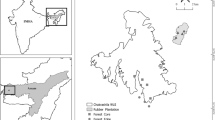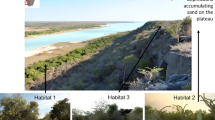Abstract
Life history traits evolve such that the reproductive output of an organism is maximized. Demographic characteristics, a consequence of life history traits, indicate the reproductive output per individual in group-living species. Both phylogenetic and ecological factors influence demographic traits. In the forests of the Western Ghats, India, we studied the demography of three langur species: Semnopithecus johnii, a wet forest-dwelling species; Semnopithecus hypoleucos, largely a wet forest-dwelling species; and Semnopithecus priam, a primarily dry forest-dwelling species. S. hypoleucos and S. priam are genetically closer to each other than to S. johnii. We sampled a total of 193 groups of the three species of langurs. The group size was smaller in the two wet forest-dwelling species, S. johnii (median = 10) and S. hypoleucos (nine), than in the dry forest-dwelling species, S. priam (18). The number of adult females per group was higher in S. priam (seven) and S. johnii (six) than in S. hypoleucos (four). On the other hand, the adult female:immature ratio, indicating reproductive output and life history, was highest in S. johnii (1:0.33) followed by S. hypoleucos (1:1) and S. priam (1:1.09). Our results suggest that reproductive output is lowest in the arboreal wet forest species and increases as the species become somewhat dry deciduous forest dwellers, or almost facultative dry forest dwellers, and relatively more terrestrial. Some traits, such as group size, appear to be more sensitive to ecological factors, and some other traits such as age-sex ratios and reproductive output appear to be more conservative.

Similar content being viewed by others
References
Altmann J, Alberts SC (2005) Growth rates in a wild primate population: ecological influences and maternal effects. Behav Ecol Sociobiol 57:490–501
Ashalakshmi NC, Chetan Nag KS, Karanth KP (2015) Molecules support morphology: species status of south Indian populations of the widely distributed Hanuman langur. Conserv Genet 16:43–58
Böhning-Gaese K, Oberrath R (1999) Phylogenetic effects on morphological, life-history, behavioural and ecological traits of birds. Evol Ecol Res 1:347–364
Borries C, Koenig A, Winkler P (2001) Variation of life history traits and mating patterns in female langur monkeys (Semnopithecus entellus). Behav Ecol Sociobiol 50:391–402
Borries C, Larney E, Lu A, Ossi K, Koenig A (2008) Costs of group size: lower developmental and reproductive rates in larger groups of leaf monkeys. Behav Ecol 19:1186–1191
Borries C, Lu A, Ossi-Lupo K, Larney E, Koenig A (2011) Primate life histories and dietary adaptations: a comparison of Asian colobines and macaques. Am J Phys Anthropol 144:286–299
Chapman CA, Rothman JM (2009) Within-species differences in primate social structure: evolution of plasticity and phylogenetic constraints. Primates 50:12–22
Charnov EL, Berrigan D (1993) Why do female primates have such long life spans and so few babies? Or life in the slow lane. Evol Anthropol 1:191–194
Chhangani AK (2002) Group composition and sex ratio in Hanuman langurs (Semnopithecus entellus) in the Aravali Hills of Rajasthan, India. Zoo’s Print J 17:848–852
Cords M, Chowdhury S (2010) Life history of Cercopithecus mitis stuhlmanni in the Kakamega Forest, Kenya. Int J Primatol 31:433–455
Deaner RO, Barton RA, van Schaik CP (2003) Primate brains and life histories: renewing the connection. In: Kappeler PM, Pereira ME (eds) Primate life histories and socioecology. Cambridge University Press, Cambridge, pp 233–265
Dunbar RIM (1987) Demography and reproduction. In: Smuts BB, Cheney DL, Seyfarth RM, Wrangham RW, Struhsaker TT (eds) Primate societies. University of Chicago Press, Chicago, pp 240–249
Fleagle JG (1999) Primate adaptation and evolution. Academic Press, San Diego
Gadgil M, Bossert WH (1970) Life historical consequences of natural selection. Am Nat 104:1–24
Gilmore D, Cook B (1981) Environmental factors in mammal reproduction. MacMillan, London
Harris TR (2006) Between-group contest competition for food in a highly folivorous population of black and white colobus monkeys (Colobus guereza). Behav Ecol Sociobiol 61:317–329
Hilgartner R, Zinner D, Kappeler PM (2008) Life history traits and parental care in Lepilemur ruficaudatus. Am J Primatol 70:2–11
Isbell LA, Young TP, Jaffe KE, Carlson AA, Chancellor RL (2009). Demography and life histories of sympatric patas monkeys, Erythrocebus patas, and vervets, Cercopithecus aethiops, in Laikipia, Kenya. Int J Primatol 30:103–124
Janson CH, Goldsmith ML (1995) Predicting group size in primates: foraging costs and predation risks. Behav Ecol 6:326–336
Kamilar JM, Cooper N (2013) Phylogenetic signal in primate behaviour, ecology and life history. Philos Trans R Soc B 368(1618):20120341
Kavana TS, Erinjery JJ, Singh M (2015a) Folivory as a constraint on social behaviour of langurs in south India. Folia Primatol 86:420–431
Kavana TS, Erinjery JJ, Singh M (2015b) Diet of Nilgiri langur Semnopithecus johnii inhabiting tropical montane shola in the Nilgiri hills, south India. Asian Primates J. 5:3–11
Koenig A (2000) Competitive regimes in forest-dwelling Hanuman langur females (Semnopithecus entellus). Behav Ecol Sociobiol 48:93–109
Koenig A, Beise J, Chalise MK, Ganzhorn JU (1998) When females should contest for food–testing hypotheses about resource density, distribution, size, and quality with Hanuman langurs (Presbytis entellus). Behav Ecol Sociobiol 42:225–237
Korstjens AH, Lehmann J, Dunbar RIM (2010) Resting time as an ecological constraint on primate biogeography. Anim Behav 79:361–374
Lee PC (1987) Nutrition, fertility and maternal investment in primates. J Zool 213:409–422
Lehmann J, Korstjens AH, Dunbar RIM (2007) Group size, grooming and social cohesion in primates. Anim Behav 74:1617–1629
Leigh SR (1994) Ontogenetic correlates of diet in anthropoid primates. Am J Phys Anthropol 94:499–522
Martin RD (1990) Primate origins and evolution: a phylogenetic reconstruction. Princeton University Press, Princeton
Moore J (1999) Population density, social pathology, and behavioral ecology. Primates 40:1–22
Nishida T, Corp N, Hamai M, Hasegawa T, Hiraiwa-Hasegawa M, Hosaka K et al (2003) Demography, female life history, and reproductive profiles among the chimpanzees of Mahale. Am J Primatol 59:99–121
Raichlen DA, Gordon AD, Muchlinski M, Snodgrass JJ (2010) Causes and significance of variation in mammalian basal metabolism. J Comp Physiol B 180:301–311
Rajpurohit LS, Sommer V (1991) Sex differences in mortality among langurs (Presbytis entellus) of Jodhpur, Rajasthan. Folia Primatol 56:17–27
Robbins MM, Bermejo M, Cipolletta C, Magliocca F, Parnell RJ, Stokes E (2004) Social structure and life-history patterns in western gorillas (Gorilla gorilla gorilla). Am J Primatol 64:145–159
Ross C (1992a) Environmental correlates of the intrinsic rate of natural increase in primates. Oecologia 90:383–390
Ross C (1992b) Basal metabolic rate, body weight and diet in primates: an evaluation of the evidence. Folia Primatol 58:7–23
Ross C (1998) Primate life histories. Evol Anthropol 6:54–63
Ross C, Jones KE (1999) Socioecology and the evolution of primate reproductive rates. In: Lee PC (ed) Comparative primate socioecology. Cambridge University Press, Cambridge, pp 73–110
Rowe N (1996) The pictorial guide to the living primates. Pogonias, New York
Roy D (2012) Group size and age-sex composition of Nilgiri langur Trachypithecus johnii (Primates: Cercopithecidae) in India. TAPROBANICA: J Asian Biodiv 4:83–87
Singh M, Sinha A (2004) Life-history traits: ecological adaptations or phylogenetic relics? In: Theirry B, Singh M, Kaumanns W (eds) Macaque societies: a model for the study of social organization. Cambridge University Press, Cambridge, pp 80–83
Snaith TV, Chapman CA (2007) Primate group size and interpreting socioecological models: do folivores really play by different rules? Evol Anthropol 16:94–106
Snodgrass JJ, Leonard WR, Robertson ML (2007) Primate bioenergetics: an evolutionary perspective. In: Ravosa MJ, Dagosto M (eds) Primate origins: adaptations and evolution. Springer, New York, pp 703–737
Stearns SC (1992) The evolution of life histories, vol. 249. Oxford University Press, Oxford
Sushma HS, Sunderraj SFW, Johnsingh AJT (2014) The Nilgiri langur. In: Johnsingh AJT, Manjeraker N (eds) Mammals of south Asia, vol 1. Universities Press, Hyderabad, pp 236–254
Vasudev D, Kumar A, Sinha A (2008) Resource distribution and group size in the common langur Semnopithecus entellus in southern India. Am J Primatol 70:680–689
Wich SA, Steenbeek R, Sterck EH, Korstjens AH, Willems EP, Van Schaik CP (2007) Demography and life history of Thomas langurs (Presbytis thomasi). Am J Primatol 69:641–651
Zucker EL, Clarke MR (2003) Longitudinal assessment of immature-to-adult ratios in two groups of Costa Rican Alouatta palliata. Int J Primatol 24:87–101
Acknowledgments
We thank the Chief Wildlife Warden and the officials of the Kerala, Tamil Nadu and Karnataka Forest Departments for permission to conduct this study and for their field assistance. We thank Mukesh Chalise and Wolfgang Dittus for comments that enhanced the quality of this article. This study was supported by a Department of Science and Technology Ramanna Fellowship, India to M. S. Our work conformed to the ethical guidelines for animal treatment of the University of Mysore, Mysore, India. Further, our work adhered to all the legal requirements for conducting wildlife research in India. Permits were obtained from the Forest Departments of Kerala, Tamil Nadu and Karnataka for fieldwork.
Author information
Authors and Affiliations
Corresponding author
About this article
Cite this article
Singh, M., Kumara, H.N., Kavana, T.S. et al. Demography and reproductive output in langurs of the Western Ghats, India. Primates 57, 501–508 (2016). https://doi.org/10.1007/s10329-016-0550-2
Received:
Accepted:
Published:
Issue Date:
DOI: https://doi.org/10.1007/s10329-016-0550-2




